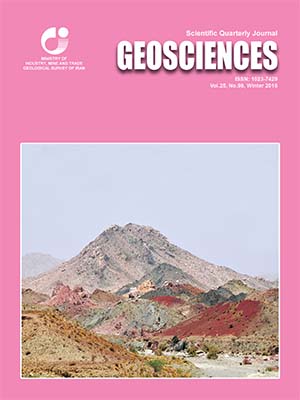Document Type : Original Research Paper
Authors
1 Ph.D., Department of Geology, Faculty of Earth Sciences, Shahid Beheshti University, Tehran, Iran
2 Professor, Department of Geology, Faculty of Earth Sciences, Shahid Beheshti University, Tehran, Iran
3 Assistant Professor, Department of Geology, Faculty of Earth Sciences, Shahid Beheshti University, Tehran, Iran
4 Ph.D., Parsi Kan Kav En. Co., Tehran, Iran
Abstract
The Madan Bozorg deposit is located in the Abbas Abad mining district, about 130 km east of Shahroud. The area is covered by a NE-SW trending belt of intermediate-mafic lava flows and pyroclastic materials, as well as interlayered sedimentary rocks. Eight copper deposits have been identified in the district. Based on the chemistry, the volcanic rocks can be classified as trachyandesite, trachyandesitic basalt and trachybasalt; the rocks display high potassium calc-alkaline to shoshonitic affinities and bear geochemical attributes characteristic of continental arc settings. The Madan Bozorg deposit is hosted in trachyandesite with porphyritic to megaporphyritic, glomeroporphyritic and amygdaloidal textures. Based on field observations, microscopic studies, Raman spectroscopy and XRD results, two types of alteration, regional and local, can be distinguished. The regional or background alteration, is comparable to a propylitic assemblage and occurs in mineralized and non- mineralized volcanic units. Local alteration associated with copper mineralization includes calcic, silicic, sericitic, chloritic, zeolitic and hematitic. Copper mineralization occurs as disseminated, vein- veinlet, replacement, stockworks and irregular open space fillings. Based on microscopic studies and EPMA data, chalcocite group minerals (chalcocite, djurleite, anilite, digenite and covellite) are the main ore minerals and are accompanied by subordinate bornite, pyrite and hematite. Secondary minerals include covellite, malachite, azurite, chrysocolla and goethite. Nonmetallic minerals are quartz, chlorite, epidote, calcite, and chalcedony. Based on fluid inclusion studies on coexisting quartz, homogenization temperatures are between 90 to 268°C with an average of 176° C. Salinities vary between 3.38 to 21.96 (average, 13.21) wt% NaCl eq. Fluid density varies between 0.8 to 1.1 g.cm-3. The depth of fluid inclusion trapping is estimated to be less than 200 meters, and ore formation occurred at pressures less than 50 bars. The host rocks, ore mineralogy, ore textures and structures, and fluid inclusions characteristics in Madan Bozorg deposit are similar to those reported from Manto type copper deposits in Mesozoic-Cenozoic volcanic belts in South America and elsewhere.
Keywords

